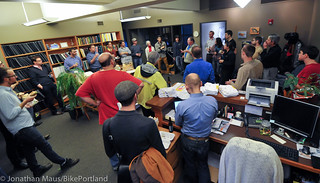
brain-power met at Lancaster Engineering
Tuesday night.
(Photos © J. Maus/BikePortland)
Staple racks at the grocery store blocked by piles of pumpkins; events with 800 people and zero additional bike parking; apartment buildings with dozens of wall hooks that are difficult and awkward to use for many people…
Portland is full of bike parking problems. Fortunately, most of them are solvable.
On Tuesday night, Jonathan and I joined the bike coordinators for Oregon’s two largest-employment universities, three representatives of bike parking equipment companies, two city employees, three architects, a team of engineers, the operator of the largest bike valet in North America and 25 other wonky Portland citizens for drinks and sandwiches to start talking about the solutions.
“In what other city,” organizer Chris Smith asked the crowd Tuesday night, “could you get 35 people to come out and talk about bike parking?”
Smith — a member of the Portland Planning and Sustainability Commission, founder of PortlandTransport.com, and noted citizen activist — ran a focused and productive event. His goal? To persuade the city’s Bureau of Transportation and the Bureau of Planning & Sustainability to begin a major update of the bike parking code. He has made a reform of the code a major priority of his second term on the planning commission.
The city’s bike parking code acts as a blueprint and legal framework for developers, landlords, homeowners, and other agencies. It tells them what type of bike parking to install, where to install it, how much of it to install, and so on. Believe it or not, the code hasn’t been updated since 1996. Since then, city planners have made tiny, incremental improvements to the code here and there; but they’ve never done a complete update.
At the Wonk Night event Tuesday night, Smith enlisted the vast transportation knowledge in our community to garner feedback on the code and collect ideas on how to reform it.
After brief introductions where each person shared their biggest bike parking gripe, attendees broke into small groups based on (but not limited to) existing subcategories in the bike parking code.
Here are some photos of the action, followed by a list of thirty ideas as shared from each group…
And here are some of the ideas they came up with…
Residential Parking:
1) Some parking should be required to be horizontal (on floor, rather than wall hooks); in San Francisco, 50% is required to be horizontal.
2) Room is needed for cargo bikes and trailers.
3) Higher ratios of parking to units may be justifiable.
4) Some portion of parking should be required to be on ground floor or parking level (rather than in living units).
5) Provide incentives in code to provide extra or higher-quality parking, such as multiple small rooms (to preserve security), climate controls or a place to hang wet clothes.
6) Provide financial incentives for landlords who retrofit additional parking into older buildings (unlinked to other redevelopment).
7) It’s OK to charge for bike parking.
Commercial Parking:
8) Link the amount of required bike parking to amount of auto parking, in ratio to the expected ratio of future trips.
9) Create a mechanism for converting auto parking to bike parking on request from building users.
10) Define bike parking as “full” when utilization hits 80%, much like the best practice for car parking.
11) Allow exceptions for auto-oriented use categories (e.g., Jiffy Lube).
12) Because keeping bike parking within 50 feet of a door is difficult with larger amounts of parking, allow a single parking facility to extend past 50 feet if it begins within 50 feet.
Transit centers:
13) Signage to bike parking is important.
14) Current code requires long-term parking to be “on site,” but OHSU’s Go By Bike valet is an example of a good facility that’s “en route” instead.
15) Current security standards in code (100 feet to security guard) don’t make much sense.
16) Card-swipe cages are missing from prominent locations like Union Station and the airport. (Indoor locations should be allowed.)
Event Parking:
17) San Francisco’s code, which requires available bike parking for 1% of expected attendees, could be useful, because it forces organizers think about bike parking without creating undue expense.
18) San Francisco also requires that bike parking be within 1/2 block of event entrance and requires that bike parking be mentioned in event advertising.
19) Since the Parks Bureau runs events, they must be involved in a fix.
Definition of parking space:
20) Abolish wave racks.
21) Require different-colored markings around bike racks to clarify where the parking space ends in order to prevent encroachment into the bike parking space.
22) Require staples be secured with tamper-proof fasteners.
23) Have dimensional standards to ensure distance from wall, etc.
24) Staples could benefit from having more than two posts, creating more places to lock to.
25) Better enforcement of four-foot distance between staples (based on 2 foot width of space as defined in code).
Additional Ideas:
26) There should be linkage between paid bike parking and paid auto parking. Conversely if auto parking is free, bike parking should be too (alternately, price ALL parking)
27) Let one building team up with another nearby one to create shared bike parking space (like the shared parking concept for auto parking).
28) Require ‘adequate’ parking rather than a particular number, making it responsive to future increases in demand.
29) Convert the second floor of city Smart Park facilities to bike parking.
30) Bike parking design/regulation must preserve pedestrian space.
What’s next? Smith said he’ll start contacting city staffers with the ultimate goal of finding money in the upcoming budget to begin an official code update project.
“I’m going to play some inside baseball for a while trying to get the bureaus on board,” Smith said. “If we get it launched, then we’re going to need community to show support for it.”
We love this project. One thing it’ll definitely have is media coverage.
— Jonathan Maus contributed to this report.
— This event was made possible by generous donations from Seattle-based bike rack company Sportworks and Omission Beer. And special thanks to Lancaster Engineering for hosting.

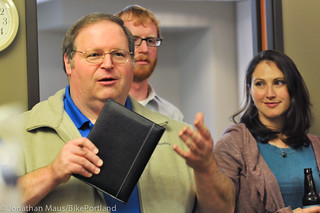
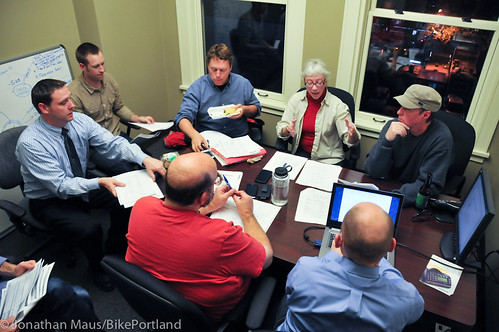



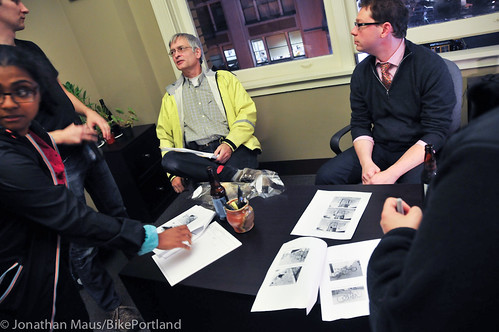
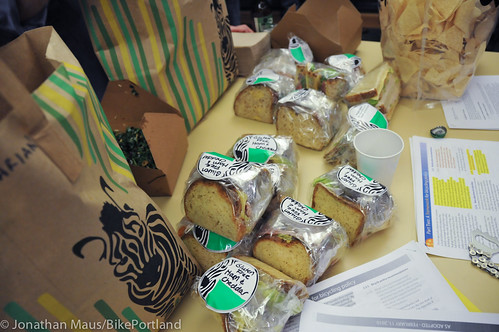



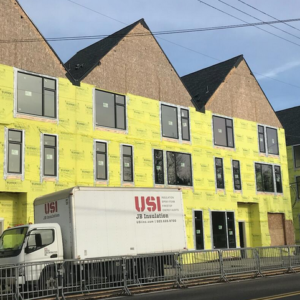
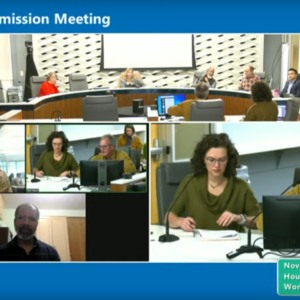
Thanks for reading.
BikePortland has served this community with independent community journalism since 2005. We rely on subscriptions from readers like you to survive. Your financial support is vital in keeping this valuable resource alive and well.
Please subscribe today to strengthen and expand our work.
Additionally, new bike parking code (and any infrastructure) needs to consider longtail and front loading cargo bikes.
And trailers. Taking my bike with our trailer to costco or the lumber yard makes me 13 feet long. Maybe “flex spaces”‘ with a few racks designed for us bike suvs. I feel like a parking hog when i am sandwiched between the staples and displays.
As usual, Michael takes better notes that I do 🙂 Thanks!
Re: commercial and event parking; cargo bike and trailers should be accommodated. With large amount of staple racks 4 feet apart, sometimes there is no way to park a cargo bike or bike+trailer without blocking the sidewalk, blocking a car parking spot, or taking up multiple bike parking spaces. The New Seasons on N Williams has this problem.
Perhaps 1 out of every 20 bike parking spaces should be able to fit a cargo bike or trailer. Usually this only requires providing a couple of feet of free space at the end of a bike corral or the end of a row of staples.
I love all these ideas. I hardly dare to dream of the day when the second floor of the Smart Park garages is full of bikes. On that note, I have often wondered why there isn’t a service like the Go by Bike Valet downtown. I realize Go by Bike is free, but it seems like a bike valet downtown would be useful and well-used, and people might be willing to pay for it.
I bring my bike into my office, and I would never lock it up anywhere else downtown. Perhaps that is why many people might shun a valet.
I don’t know where the current code can be found, so these ideas might come off as ignorant. Apologies if so.
Unify the parking code as much as possible, treating automotive and human powered parking in the same breath. (Ideally, the Portland code would serve as a model that both other municipalities and larger governments can readily adopt, even if it needs to be redundant with existing codes, e.g. state law.)
Allow developers the option of trading, say, up to 5% of their required automobile parking for a ratio of, say, 6 bicycle locations for every automobile spot displaced. Since bicycle parking is inherently more flexible than automotive, some developers would opt for racks because they are cheaper and more aesthetic. This in addition to minimum standards for both.
Add an exception to the “no riding bikes on sidewalks” law in downtown that allows for equivalent access to parking facilities for bicycles as automobiles currently enjoy. (In other words, cyclists should be able to legally mount and dismount on a sidewalk the way cars drive across them to reach garages–though using the sidewalk as a traffic lane is still prohibited.)
Be a little bit careful about the linkage – in some cases we require no auto parking, but do require bike parking 🙂
We already offer folks who are required to provide auto parking the opportunity to “buy down” the required amount. Options to provide alternatives include:
– more bike parking than required
– installing a bike share station (subject to approval by system operator and PBOT)
– installing car share spaces
– putting a public plaza on your property
Parking code available at http://www.portlandoregon.gov/bps/index.cfm?&a=53320
I think wave racks are great (and secure) when they are installed correctly. I would love to see code that specifies they are the correct distance from the building they are in front of.
Hmm… some additional comments, since I wasn’t able to make it:
Residential bike parking: It seems like there should be at least one bike parking space required per residential unit; this should be the floor, and there should also be a requirement for visitor bicycle parking… If this 1:1 ratio were required, would 50% of it need to be horizontal? Maybe not… maybe less, though 25% horizontal seems like a good minimum.
Commercial bike parking: I don’t think that auto-oriented use categories should get an exception from the need to provide bike parking. Not only is it not only possible, but quite likely, that their employees may wish to ride their bicycles to work (especially in this town), but their customers may also wish to ride their bikes to come pick up their cars, or home after they drop off their cars. I’ve done it. So, no exceptions, all businesses must provide some amount of bike parking, for both employees and customers. Freight businesses, too. Every employee of every business should have the option to bike to work, safely, with secure bike parking.
Transit parking: +1 for the comment about card-swipe stations being missing from the airport. I would ride my bike to the airport, instead of taking a taxi, if I knew that I could lock my bike securely for a whole week, with absolutely no question that it would be safe while I was gone. Make it so!
Event parking: 1% seems very low, this is Portland. 5%? 10%? Those still seem low, but more reasonable. Is there some way for this to be flexible?
Definition of bike parking spaces: Yes, freight cycle parking needs to be clarified here; I like the idea of percentages, what if 10% of all spaces need to be sized to accommodate either a bakfiets-type-bike or a bike with a trailer?
Finally, access to bike parking: This gets back to us needing to build out our bicycle network, but currently it’s easy to find plenty of examples of world-class bicycle parking facilities, with nary an actual bicycle network connection to or from them… but, that’s a separate conversation…
The residential ratios were one of the ‘incremental’ improvements we were able to make a few years ago. They are currently (for apartments and condos): 1.1 spaces/unit city-wide, 1.5 spaces/unit in the central city.
But commercial ratios have NOT been updated since the 90s
Thank you, Chris, for organizing the meeting & starting this needed conversation.
On the subject of paid bike parking: no suggestions about rates? (“bike parking should cost x% of automobile parking”) Also, charging for bike parking is a disincentive to riding a bike. If we want to encourage cycling, why the statement about “if charging for car parking, then charge for bike parking”? (I may gave mis-read that.)
I think the linkage was unless the location charged for car parking they could not charge for bike parking.
The comment as I recall from the meeting was, “if the car parking is free, then there should be no charge for the bike parking either.”
Does that make more sense?
Woops, just saw your response, Opus the Poet. I agree.
Good times, thanks for bringing this forward, Chris! I hope we see significant improvements in Portland’s end-of-trip facilities over the years as a result of these efforts.
& thanks to the Lancaster folks for hosting the event and after-party.
Ted Buehler